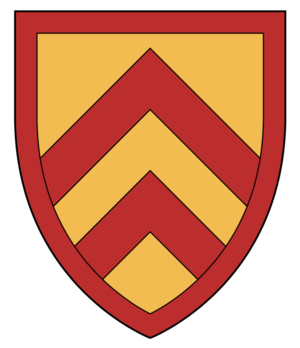William d'Aubigny (rebel) facts for kids
William d'Aubigny (also spelled D'Aubeney or d'Albini) was an important English noble who lived a long time ago. He was known as the Lord of Belvoir. William was a key figure in the group of nobles who stood up against King John of England. He is famous for being one of the people who signed the Magna Carta, a very important document in English history. He passed away on May 1, 1236.
His Family and Home
William d'Aubigny was the son of another William d'Aubigny of Belvoir and his mother was Maud FitzRobert. His grandfather was also named William d'Aubigny. His family was very old and important. They inherited many lands from an ancestor named Robert de Toeni. Robert de Toeni was listed in the Domesday Book, which was a huge survey of land and property in England made in 1086.
One of the most important places the family owned was in Leicestershire. Here, they built Belvoir Castle, which became their main home for many, many years. William d'Aubigny himself held important jobs for the king. In 1199, he was a High Sheriff of Warwickshire and Leicestershire. He was also a High Sheriff of Bedfordshire and Buckinghamshire. A High Sheriff was a royal official in charge of a county, making sure laws were followed.
Fighting for Change
At first, William d'Aubigny tried to stay out of the arguments between King John and his nobles. But when the nobles successfully took control of London in 1215, William decided to join their side. He became one of the twenty-five "sureties" or guarantors of the Magna Carta. This meant he promised to make sure the king followed the rules set out in the Magna Carta.
After the Magna Carta was signed, a war broke out. William d'Aubigny bravely defended Rochester Castle for the rebelling nobles. However, King John managed to capture the castle. William was taken prisoner and almost executed.
Later, when King Henry III became king in October 1216, William d'Aubigny changed his loyalty and supported the new young king. He even became a leader in the king's army. He fought as a commander in the Second Battle of Lincoln on May 20, 1217. This battle was a big victory for King Henry III's supporters.
His Later Years and Legacy
William d'Aubigny died on May 1, 1236. He passed away in a place called Uffington, Lincolnshire. He was buried at Newstead Abbey. It is also said that his heart was buried separately at Belvoir Castle, near the altar.
His son, who was also named William d'Aubigny, took over his lands and titles. However, this son died in 1247 and only had daughters. One of his daughters, Isabel, became a co-heiress, meaning she shared the inheritance. She married a man named Robert de Ros.


